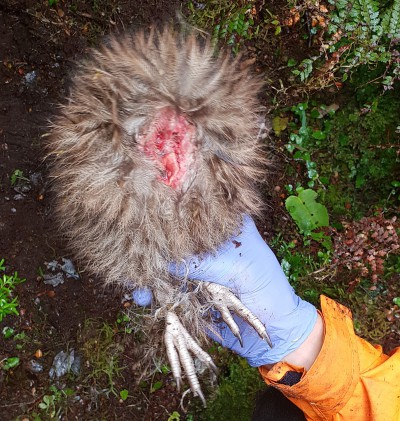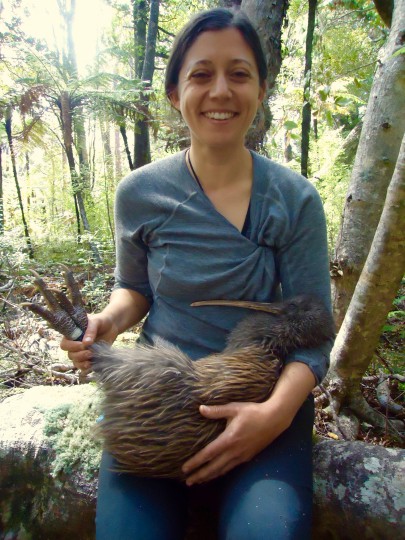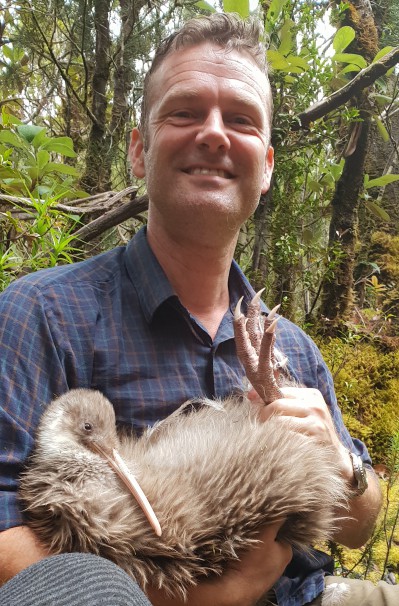Results to mid-2020
DNA diagnostics in dog attacks

Remains of newly fledged Fiordland tokoeka chick. Of ca 20 chicks followed by DOC staff, none lasted longer than 2 weeks.
Administering councils and the Department of Conservation dealing with dog attacks on kiwi, stock, and people now have a reliable DNA-based diagnostic tool to identify culprit dogs (DogFiler). There has now been a successful prosecution with this tool, by Tauranga City Council in May 2019 for a stock and cat attack, and a multiple kiwi kill situation is also being prosecuted.
Researcher: Hester Roberts.
Our community-based surveys in Northland, where dog-kiwi interactions are greatest, have clarified major clusters of views about dogs and how they should be managed, that will also benefit other dog control situations (e.g. penguins, shorebirds, stock).
Researchers: Robyn Kannemeyer, Patrick Walsh.
Our dog-owner-kiwi research is nationally leading and relevant to many end-users such as Capital Kiwi, Wellington. It suggests that the issue is social and complex and needs diverse approaches, and that a nation-wide responsible dog ownership programme that is supported and managed by councils would help protect kiwi, other wildlife, livestock, and the general public.
Haast tokoeka
Our genetic markers and analyses have revealed a new population of Haast tokoeka that is a large boost to the known small population. Individual stoats and ferrets can now be identified from saliva on dead kiwi, and matched against DNA of trapped animals, and genetic characterisation of stoats nationally is now complete. We have successfully identified kiwi DNA from cat scats on Rakiura, and in vitro from stoat scats.
Researchers: Hester Roberts and Talia Brav-Cubitt.
Field surveys at four sites have resolved that environmental DNA from kiwi scats and feathers located by humans is inadequate to estimate population size unless a trained dog helps find them; we are now training such a dog.
Researcher: Danielle Middleton.
Rakiura (Stewart Island) tokoeka

Emma Feenstra (Massey University PhD student) with Rakiura (Stewart Is.) tokoeka. This is New Zealand’s largest kiwi species.
The PhD research of Emma Feenstra and supervisor Dr Isabel Castro (Massey University) on the little known Rakiura tokoeka has enabled 47 kiwi to have transmitters attached – 21 on Ulva Island and 26 at Kaipipi on Rakiura.
This initial monitoring has found abundant birds of various ages including young chicks sharing the same burrows, demonstrating successful recruitment of young despite feral cats. Along with DOC monitoring, this research has raised hopes that Rakiura tokoeka are not in fact declining at more than 2% p.a. as previously suspected.
Researchers: Emma Feenstra and Isabel Castro
Using acoustic recorders to monitor kiwi population by recording calls
Dr Isabel Castro (Massey University) has been funded by this programme to study how best to use digital field recorders (microphones) to capture kiwi calls and see if they increase when and where there is intensive pest control. Isabel has shown that digital recorders and humans are similar to each other in the ability to detect calls.
Researcher: Isabel Castro
Kiwi management
Working with Kiwis for Kiwi, we have increased Māori participation in kiwi management. We have completed a downloadable GIS package associated with the previously reported kiwi distribution and Māori land maps (WhenuaViz).
Researcher: Kiri Reihana.
Working with Ngāti Rangi, we have trialled a mātauranga tool to assess kiwi conservation success based on the Wai Ora framework.
Machine recognition of trap images

Dr Al Glen (MWLR) with Fiordland tokoeka (brown kiwi).
Image processing software has been adapted from Australian models. The software is now up to 99% accurate in filtering out target species (e.g. kiwi, stoat) from “junk” images (e.g. sheep, cattle, false triggers). It is now up to 91% accurate in automatically identifying species in photographs, and can process thousands of images per day. Researcher Dr Al Glen is also trialling DOC’s new draft stoat monitoring regime with cameras at Shy Lake, Fiordland. DOC has been monitoring kiwi (Fiordland tokoeka) chick survival at this site also, enabling the two measures to be calibrated against each other. We are also going to see how the camera index of the stoat population changes when there is an aerial 1080 operation, that is likely to kill many stoats.
Researcher: Al Glen
Pest control strategies and public acceptance
We worked with the Biological Heritage National Science Challenge to survey 8000 people about public acceptance of new pest control technologies. Among other results, rats and stoats were preferred targets to wasps and ground delivery of toxins was significantly preferred to aerial.
Researcher: Ben Wiercinski.
Some views about pest control approaches varied between types of participant, and we concluded that considering demographic and value groups affects recommendations for communication campaigns.
